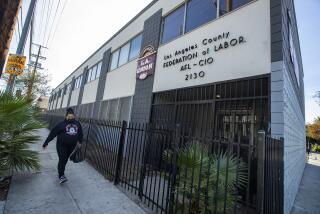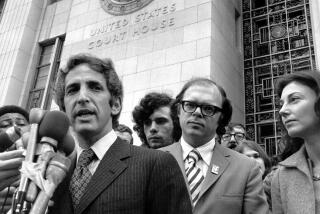Details of an Ill-Fated, Surreal Cover-Up Arise
- Share via
WASHINGTON — On a Monday in mid-July last year, President Clinton called a late-night meeting at the White House to talk about damage control.
Kathleen E. Willey, a former volunteer in the White House, had told friends that the president had groped and kissed her during a 1993 visit to the Oval Office and a Newsweek reporter was asking questions about the incident.
The timing was especially bad for Clinton. The Supreme Court had cleared the way for Paula Corbin Jones’ sexual harassment lawsuit to go to trial and her lawyers were seeking information on other women who had sexual encounters with him.
So, the president called in a confidant to help.
Unfortunately for him, her name was Monica S. Lewinsky.
The Clinton White House was thought to have a superb damage-control operation, with the president and his aides moving quickly and decisively to knock down potentially explosive stories about his private life.
But in a spectacular misstep, the president decided during the July 14 meeting to use Lewinsky as an emissary to Linda Tripp, a disgruntled former White House aide who was Lewinsky’s friend and the apparent source of the Willey story.
The president “was concerned about Linda,” Lewinsky testified. “I reassured him. He asked me if I trusted her [Tripp] and I said yes,” she continued.
As recounted in the report sent to the House Friday by independent counsel Kenneth W. Starr, the surreal scene shows how the Clinton strategy began to unravel.
In the months that followed, an increasingly worried president used all the means at his disposal--and legal means certainly--to keep his private indiscretions from exploding into public view.
That included the use of friends such as Washington lawyer Vernon E. Jordan Jr. to find a New York job for Lewinsky, as well as secret hand-holding meetings and exchanges of gifts with her. By then, Clinton had ended his sexual encounters with Lewinsky, fearing that word of the affair already had leaked out.
Via his longtime aide Marsha Scott, the president had learned in May 1997, that rumors of a Clinton-Lewinsky affair were circulating at the Democratic National Committee. On May 24, he told a weeping Lewinsky that their sexual relationship was over.
But the overwrought former White House intern, now a spurned lover, continued to call Clinton, even threatening to reveal their affair, according to her testimony. By mid-July, the president was growing anxious that someone was leaking tales of his sexual encounters.
Some were appearing in the “Sludge Report,” he told her, an apparent slap at the “Drudge Report,” Matt Drudge’s Internet news flash that often has carried the first tips of new Clinton scandals.
For nearly an hour, the president broke away from Lewinsky to speak by phone with his private lawyer Robert S. Bennett and White House Counsel Charles F.C. Ruff. Bennett was then trying to arrange a settlement of Jones’ sexual harassment suit. Despite a $700,000 offer, the ex-Arkansas state clerk would not settle without an apology from Clinton.
If Willey’s story became public, Jones’ lawyers would have powerful new ammunition to show a pattern of behavior on Clinton’s part.
After his phone call, the president--in a “sour mood”--told Lewinsky to urge Tripp to keep quiet and to report back to his secretary with the words “mission accomplished” if she succeeded, she testified.
The mission failed--and spectacularly so.
Not only did Tripp continue speaking to a Newsweek reporter, she also continued talking with Lewinsky about her efforts to resume her sexual affair with Clinton.
On Aug. 17, Newsweek published a story quoting Tripp as describing a “disheveled” Kathleen Willey leaving the Oval Office.
In response to the story, Bennett was quoted as saying that Tripp was “not to be believed.”
That in turn prompted Tripp, she has said, to begin recording her conversations with Lewinsky.
By October, Jones had hired a new team of Dallas lawyers to pursue her sexual harassment claim and they moved aggressively to find other women with tales to tell.
Meanwhile, Lewinsky was continuing to make calls and to send notes to the president. On Oct. 16, she sent him “a wish list,” topped by her desire to work in “strategic planning at the White House.”
Not surprisingly, Clinton passed up that suggestion but had aides speak with her about a possible job at the United Nations in New York.
Though a job offer came her way, Lewinsky turned it down in late November.
By then, Jones lawyers had learned of her, thanks apparently to Tripp and New York literary agent Lucianne Goldberg. On December 15, the lawyers sent Clinton a subpoena demanding “documents that related to communications between the President and Monica Lewisky [sic].”
Two days later, Clinton phoned Lewinsky at 2 a.m., telling her it “broke his heart” to see her name on the witness list. On Dec. 19, Lewinsky received at the Pentagon her own subpoena, which was amazingly specific in its demands. For example, she was told to turn over any “hat pins given to you by or on behalf of defendant Clinton.” One of his last gifts to her had been a hat pin.
She “broke into tears.” Their secret encounters in the hallway near the Oval Office would not be secret much longer.
On Jan. 17, the president sat down with Jones’ lawyers, supposedly to answer questions about the alleged incident at a Little Rock hotel. Instead, he spent most of the day being interrogated about his relationship with Lewinsky.
Times on the Web
* The Starr report, White House rebuttals and The Times Poll of public opinion on President Clinton are on The Times’ Web site: https://www.latimes.com/scandal
More to Read
Sign up for Essential California
The most important California stories and recommendations in your inbox every morning.
You may occasionally receive promotional content from the Los Angeles Times.














